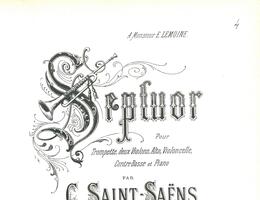Septet op. 65
Septet for trumpet, two violins, viola, cello, double bass and piano in E-flat major, in four movements (I. Préambule, II. Menuet, III. Intermède, IV. Gavotte et Final), composed in 1879-1880. First performance of the Préambule on 6 January 1880, and of the complete work on 28 December 1880.
“When I think how you tormented me to make me write this piece that I didn’t want to write and that became one of my great successes, I never understood why.” Saint-Saëns addressed these few words to Émile Lemoine (1840-1912), the dedicatee of the Septet, op. 35 in October 1907. The composer also recalled the genesis of the work, which he wrote especially for “La Trompette”, a chamber music society founded by Lemoine. On 29 December 1879, Saint-Saëns presented the first part (Préambule) to Lemoine, who scheduled the premiere on 6 January 1880 in the hall of the Société d’Horticulture (84, rue de Grenelle), where the society traditionally met. On 28 December of the same year, the complete work — the Préambule was supplemented by a Menuet, an Intermède (originally titled Marche funèbre), and a Gavotte et Final — was premiered; Saint-Saëns played the piano part, accompanying, on the trumpet, Xavier-Napoléon Teste (1833-1905/1906), whose talent certainly helped convince Saint-Saëns to compose for this instrument. This Septet is built in the style of the old “suites” — as the work was originally titled – and can be performed with a double string quartet. It met with undeniable success during Saint-Saëns’s lifetime, as evidenced by the numerous performances and enthusiastic reviews in the press, as well as the large number of copies printed by Durand after the first edition in March 1881. Saint-Saëns arranged the Septet for piano, violin and cello trio (November 1881), and the Menuet and Gavotte for two pianos (August 1881). Gabriel Fauré (1845-1924) offered a version for two pianos (October 1881).

